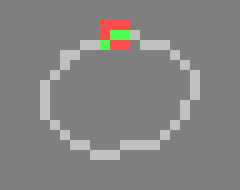This is the Torch/PyTorch library for training Submanifold Sparse Convolutional Networks. If you find this code useful in your research then please cite:
Submanifold Sparse Convolutional Networks, https://arxiv.org/abs/1706.01307
Benjamin Graham,
Laurens van der Maaten,
@article{SubmanifoldSparseConvNet,
title={Submanifold Sparse Convolutional Networks},
author={Graham, Benjamin and van der Maaten, Laurens},
journal={arXiv preprint arXiv:1706.01307},
year={2017}
}
This library brings Spatially-sparse convolutional networks to Torch/PyTorch. Moreover, it introduces Submanifold Sparse Convolutions, that can be used to build computationally efficient sparse VGG/ResNet/DenseNet-style networks.
With regular 3x3 convolutions, the set of active (non-zero) sites grows rapidly:

With Submanifold Sparse Convolutions, the set of active sites is unchanged. Active sites look at their active neighbors (green); non-active sites (red) have no computational overhead:

Stacking Submanifold Sparse Convolutions to build VGG and ResNet type ConvNets, information can flow along lines or surfaces of active points.
Disconnected components don't communicate at first, although they will merge due to the effect of strided operations, either pooling or convolutions. Additionally, adding ConvolutionWithStride2-SubmanifoldConvolution-DeconvolutionWithStride2 paths to the network allows disjoint active sites to communicate; see the 'VGG+' networks in the paper.


From left: (i) an active point is highlighted; a convolution with stride 2 sees the green active sites (ii) and produces output (iii), 'children' of hightlighted active point from (i) are highlighted; a submanifold sparse convolution sees the green active sites (iv) and produces output (v); a deconvolution operation sees the green active sites (vi) and produces output (vii).
SparseConvNet supports input with different numbers of spatial/temporal dimensions.
Higher dimensional input is more likely to be sparse because of the 'curse of dimensionality'.
| Dimension | Name in 'torch.nn' | Use cases |
|---|---|---|
| 1 | TemporalConvolution | Text, audio |
| 2 | SpatialConvolution | Lines in 2D space, e.g. handwriting |
| 3 | VolumetricConvolution | Lines and surfaces in 3D space or (2+1)D space-time |
| 4 | - | Lines, etc, in (3+1)D space-time |
We use the term 'submanifold' to refer to input data that is sparse because it has a lower effective dimension than the space in which it lives, for example a one-dimensional curve in 2+ dimensional space, or a two-dimensional surface in 3+ dimensional space.
In theory, the library supports up to 10 dimensions. In practice, ConvNets with size-3 SVC convolutions in dimension 5+ may be impractical as the number of parameters per convolution is growing exponentially. Possible solutions include factorizing the convolutions (e.g. 3x1x1x..., 1x3x1x..., etc), or switching to a hyper-tetrahedral lattice (see Sparse 3D convolutional neural networks).
SparseConvNets can be built either by defining a function that inherits from torch.nn.Module or by stacking modules in a sparseconvnet.Sequential:
import torch
import sparseconvnet as scn
# Use the GPU if there is one, otherwise CPU
use_gpu = torch.cuda.is_available()
model = scn.Sequential().add(
scn.SparseVggNet(2, 1,
[['C', 8], ['C', 8], ['MP', 3, 2],
['C', 16], ['C', 16], ['MP', 3, 2],
['C', 24], ['C', 24], ['MP', 3, 2]])
).add(
scn.SubmanifoldConvolution(2, 24, 32, 3, False)
).add(
scn.BatchNormReLU(32)
).add(
scn.SparseToDense(2,32)
)
if use_gpu:
model.cuda()
# output will be 10x10
inputSpatialSize = model.input_spatial_size(torch.LongTensor([10, 10]))
input = scn.InputBatch(2, inputSpatialSize)
msg = [
" X X XXX X X XX X X XX XXX X XXX ",
" X X X X X X X X X X X X X X X X ",
" XXXXX XX X X X X X X X X X XXX X X X ",
" X X X X X X X X X X X X X X X X X X ",
" X X XXX XXX XXX XX X X XX X X XXX XXX "]
#Add a sample using setLocation
input.addSample()
for y, line in enumerate(msg):
for x, c in enumerate(line):
if c == 'X':
location = torch.LongTensor([x, y])
featureVector = torch.FloatTensor([1])
input.setLocation(location, featureVector, 0)
#Add a sample using setLocations
input.addSample()
locations = []
features = []
for y, line in enumerate(msg):
for x, c in enumerate(line):
if c == 'X':
locations.append([x,y])
features.append([1])
locations = torch.LongTensor(locations)
features = torch.FloatTensor(features)
input.setLocations(locations, features, 0)
# Optional: allow metadata preprocessing to be done in batch preparation threads
# to improve GPU utilization.
#
# Parameter:
# 3 if using MP3/2 pooling or C3/2 convolutions for downsizing,
# 2 if using MP2 pooling for downsizing.
input.precomputeMetadata(3)
model.train()
if use_gpu:
input.cuda()
output = model.forward(input)
# Output is 2x32x10x10: our minibatch has 2 samples, the network has 32 output
# feature planes, and 10x10 is the spatial size of the output.
print(output.size(), output.data.type())
Convolutional networks are built with SparseConvNet in the same way as with Torch's nn/cunn/cudnn packages.
--Train on the GPU if there is one, otherwise CPU
scn=require 'sparseconvnet'
tensorType = scn.cutorch and 'torch.CudaTensor' or 'torch.FloatTensor'
model = scn.Sequential()
:add(scn.SparseVggNet(2,1,{ --dimension 2, 1 input plane
{'C', 8}, -- 3x3 VSC convolution, 8 output planes, batchnorm, ReLU
{'C', 8}, -- and another
{'MP', 3, 2}, --max pooling, size 3, stride 2
{'C', 16}, -- etc
{'C', 16},
{'MP', 3, 2},
{'C', 24},
{'C', 24},
{'MP', 3, 2}}))
:add(scn.Convolution(2,24,32,3,1,false)) --an SC convolution on top
:add(scn.BatchNormReLU(32))
:add(scn.SparseToDense(2))
:type(tensorType)
--[[
To use the network we must create an scn.InputBatch with right dimensionality.
If we want the output to have spatial size 10x10, we can find the appropriate
input size, give that we uses three layers of MP3/2 max-pooling, and finish
with a SC convoluton
]]
inputSpatialSize=model:suggestInputSize(torch.LongTensor{10,10}) --103x103
input=scn.InputBatch(2,inputSpatialSize)
--Now we build the input batch, sample by sample, and active site by active site.
msg={
" O O OOO O O OO O O OO OOO O OOO ",
" O O O O O O O O O O O O O O O O ",
" OOOOO OO O O O O O O O O O OOO O O O ",
" O O O O O O O O O O O O O O O O O O ",
" O O OOO OOO OOO OO O O OO O O OOO OOO ",
}
input:addSample()
for y,line in ipairs(msg) do
for x = 1,string.len(line) do
if string.sub(line,x,x) == 'O' then
local location = torch.LongTensor{x,y}
local featureVector = torch.FloatTensor{1}
input:setLocation(location,featureVector,0)
end
end
end
--[[
Optional: allow metadata preprocessing to be done in batch preparation threads
to improve GPU utilization.
Parameter:
3 if using MP3/2 or size-3 stride-2 convolutions for downsizeing,
2 if using MP2
]]
input:precomputeMetadata(3)
model:evaluate()
input:type(tensorType)
output = model:forward(input)
--[[
Output is 1x32x10x10: our minibatch has 1 sample, the network has 32 output
feature planes, and 10x10 is the spatial size of the output.
]]
print(output:size())
Examples in the examples folder include
- Assamese handwriting recognition
- Chinese handwriting for recognition
- ModelNet-40 Object recognition using 3dcnn.torch preprocessed data
Data will be downloaded/preprocessed on the first run, i.e.
cd examples/Assamese_handwriting
th VGGplus.lua
or
cd examples/Assamese_handwriting
python VGGplus.py
Tested with Ubuntu 16.04. Install Torch and/or PyTorch (Miniconda) then:
apt-get install libsparsehash-dev
git clone git@github.com:facebookresearch/SparseConvNet.git
then
cd SparseConvNet/Torch/
luarocks make sparseconvnet-0.1-1.rockspec
and/or
cd SparseConvNet/PyTorch/
python setup.py develop
To run the examples you may also need to install unrar and TorchNet:
apt-get install unrar
and
luarocks install torchnet
or
pip install git+https://github.com/pytorch/tnt.git@master
- ICDAR 2013 Chinese Handwriting Recognition Competition 2013 First place in task 3, with test error of 2.61%. Human performance on the test set was 4.81%. Report
- Spatially-sparse convolutional neural networks, 2014 SparseConvNets for Chinese handwriting recognition
- Fractional max-pooling, 2014 A SparseConvNet with fractional max-pooling achieves an error rate of 3.47% for CIFAR-10.
- Sparse 3D convolutional neural networks, BMVC 2015 SparseConvNets for 3D object recognition and (2+1)D video action recognition.
- Kaggle plankton recognition competition, 2015 Third place. The competition solution is being adapted for research purposes in EcoTaxa.
- Kaggle Diabetic Retinopathy Detection, 2015 First place in the Kaggle Diabetic Retinopathy Detection competition.
- Submanifold Sparse Convolutional Networks, 2017 Introduces deep 'submanifold' SparseConvNets.
- Workshop on Learning to See from 3D Data, 2017 First place in the semantic segmentation competition. Report